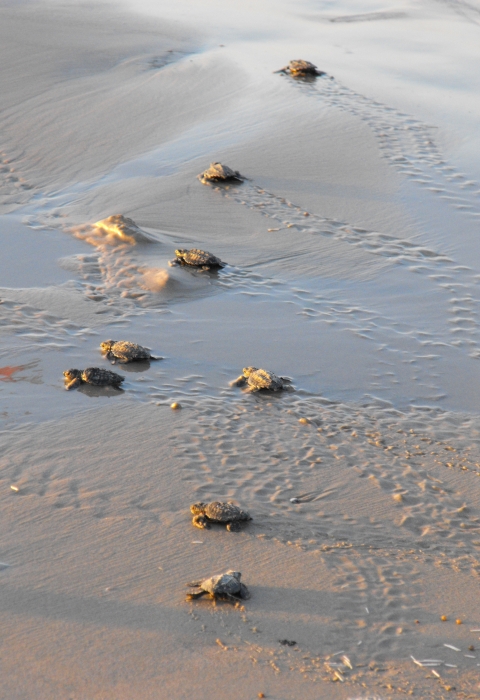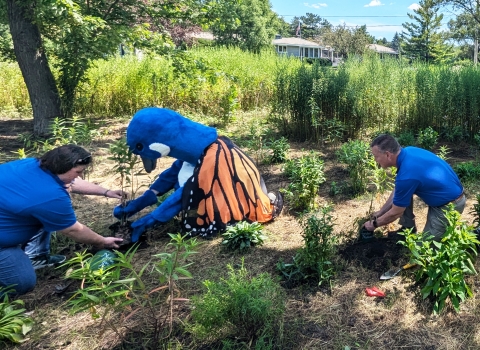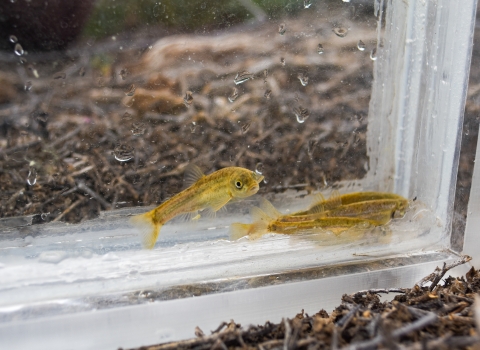This year’s sea turtle nesting season began on April 1, 2013. Last year, the number of Kemp’s ridley sea turtle nests found in Texas rose to 209 from 199 in 2011 and 141 in 2010. Biologists want to stress the importance of locating and protecting every sea turtle nest on the Texas Gulf Coast. By keeping an eye out for Kemp’s ridley sea turtles on the Texas coast you can help protect the most critically endangered sea turtle in the world.
The U.S. Fish and Wildlife Service (Service), the National Park Service, NOAA Fisheries, Texas Parks and Wildlife Department, Texas A&M University at Galveston, UT Marine Science Institute’s ARK in Port Aransas, and Sea Turtle Inc on South Padre Island work together to coordinate the response when a nesting sea turtle or sea turtle nest is found. Efforts will be on-going during nesting season to find and protect the nesting turtles and their eggs, to ensure their survival and continued population growth. Biologists and volunteers will be patrolling Texas Gulf beaches daily from April through July. Patrols will be held during the day since these two-foot-long turtles come ashore for nesting mostly during daylight hours. Other species of turtles occasionally nest at night along the Texas coast.
Benjamin N. Tuggle, Ph.D., the Service’s Southwest Regional Director said, “This is the kind of cooperative effort that will eventually lead to success in saving these sea turtles as well as other imperiled species.”
Beach goers play an important role in the detection of Kemp's ridley sea turtle nests, with many of the nests being found and reported by the public. Visitors to Texas beaches from April through late September are urged to watch for nesting adult sea turtles and emerging hatchlings and report them immediately.
If a nesting mother is seen, the Service advises visitors to quickly report the event by calling 1-866-TURTLE5 (1-866-887-8535). This telephone line is provided for and maintained by STRP. Visitors must keep their distance and not disturb her. The female turtle will dig a nest in the sand and lay her eggs. After the turtle is finished laying her eggs, those in the vicinity must allow her to enter the surf and, if possible, remain at the site until a biologist arrives. Nesting sites should be marked by carefully laying pieces of beach debris, such as pieces of wood or plastic, in a large circle around the nest area, not on top, so biologists will be able to find the nest when they arrive. The nesting sites should never be walked on or disturbed.
In order to further help protect the species, the public is asked to drive slowly and carefully on beaches during the nesting and hatching seasons so that vehicles do not inadvertently collide with nesting turtles or emerging hatchlings. The maximum speed on a Texas beach per the Texas Transportation Code is 15 mph. Those visiting the beaches should be prepared for short delays in order to ensure that nesting turtles and hatchlings remain safe and undisturbed.
In 1947, an estimated 40,000 Kemp’s ridley turtles nested on one stretch of beach near Rancho Nuevo, Mexico. This was the only known nesting site at that time. Over the next four decades the species suffered a devastating decline. The nesting population produced a low of 702 nests in 1985 making it the most endangered species of sea turtle in the world. In response to the dramatic loss of this species, the Service and its partner agencies launched a cooperative international project aimed at nest protection efforts in the U.S. and Mexico, implementing regulations requiring the use of turtle excluder devices on commercial fishing trawlers, and establishing a second nesting colony of Kemp’s ridley sea turtles at Padre Island National Seashore, Texas, where scattered nesting had been documented. These cooperative efforts are now paying off for the Kemp’s ridley sea turtle.
Kemp’s ridley sea turtles are protected by the Endangered Species Act. Anyone who takes (to kill, harm, harass, pursue, hunt, shoot, wound, trap, capture, or collect, or attempt to engage in any such conduct), or has in their possession any part of these endangered turtles, could be found guilty of a Class A misdemeanor, with penalties of up to one year in jail and $100,000 fine for an individual, and $200,000 for an organization.



